RBA Annual Conference – 2007 Innovation and Integration in Financial Markets and the Implications for Financial Stability Rob Hamilton, Nigel Jenkinson and Adrian Penalver[1]
1. Introduction
Fuelled by rapid financial innovation, deregulation and capital market integration, in recent years we have witnessed a period of tremendous growth and structural change in financial market activity and in financial intermediation across the globe. These developments are profound, with major implications for the performance, risk and management of the global financial system.
A few statistics help to illustrate the scale of these developments and the pace of change. First, growth in the financial sector has strongly outpaced that of GDP in the major industrial economies, with the share of the financial sector in total value added rising a third from 5 per cent to nearly 7 per cent since 1985 (Ferguson et al, forthcoming). Second, the global stock of financial assets has surged from just over 100 per cent of global GDP in 1980 to over 300 per cent in 2005 (Figure 1) with cross-border holdings rising even quicker. Foreign exchange market activity has increased twelve-fold since the first BIS survey in 1986, while turnover on the London Stock Exchange has increased five-fold in half this time (Figure 2). There has also been tremendous growth in the number and coverage of new types of derivatives and financial instruments. For example, the BIS reports that by the end of 2006 the outstanding value of interest rate swaps and other derivatives had reached over US$400tr (8½ times global GDP), from under US$75tr (2½ times GDP) 10 years ago (Figure 3).
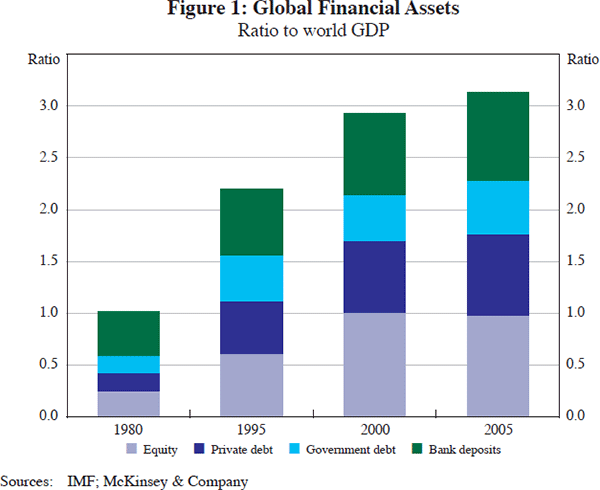
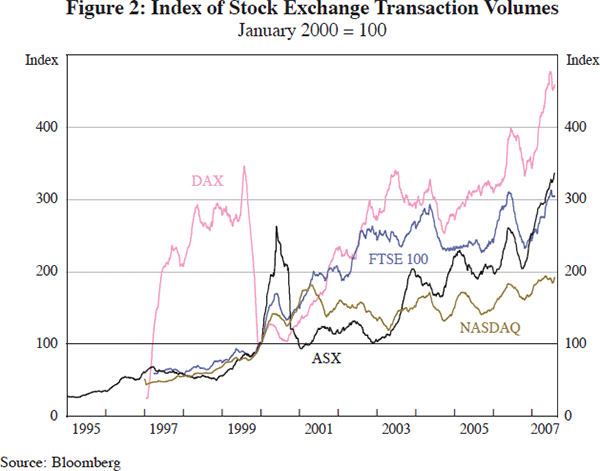
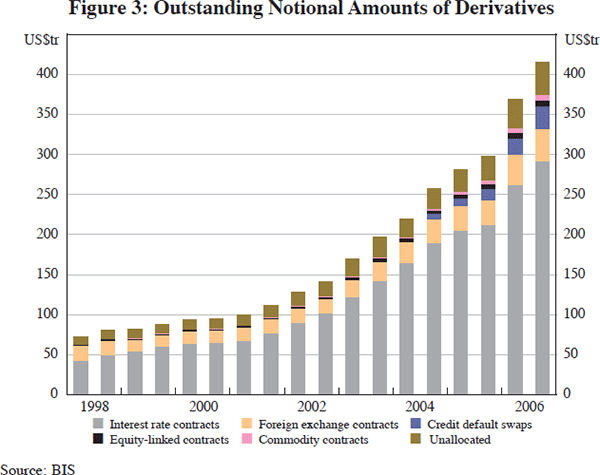
Statistics, though, do not completely capture the extent to which innovation and change have made the financial system more integrated and globalised. In recent years, there has been much greater scope to pool and transfer risks, potentially offering substantial welfare benefits for borrowers and lenders. That has been supported by the increased ability of financial institutions to manage risks within the financial system itself. But primitive risk does not disappear through financial engineering. Rather, it is transformed and reshaped. This transformation of risk poses challenges for risk management systems in financial institutions and for public authorities charged with supporting financial stability.
This paper seeks to review these issues. Section 2 argues that financial market deregulation and technological change have been key drivers behind the rapid growth and innovation in the provision of financial services. Section 3 discusses the welfare gains to households and corporations – the ultimate users of financial services – while Section 4 explores the main implications for the financial system. Section 5 looks forward and reviews some of the emerging issues for the financial sector and for the risks to financial stability. Section 6 draws out the challenges for financial stability authorities.
2. Drivers for the Changes in the Provision of Financial Services
As discussed by the Group of Ten (G10), there has been no single dominant cause of the rapid increase and changing nature of financial intermediation (G10 2001). Instead, there have been numerous supporting influences. We would highlight the fundamental importance of deregulation and heightened international competition, and of advances in information and communication technology that underpin financial innovation.
Widespread deregulation of the financial system in recent decades has had a major impact on the supply of financial services (Ferguson et al, forthcoming). For example, the removal of quantity rationing and price controls substantially expanded the freedom of financial institutions to increase their balance sheets, offer a wider range of services and compete with each other. Regulatory barriers to cross-border activity – including exchange controls – have been progressively removed in most countries, facilitating diversification of risk and again strengthening competition and the ability to transfer technological advances and to exploit economies of scale. As one illustration, 30 per cent of G7 banks' lending is now cross-border, up from 7 per cent in 1970. And takeovers and mergers within the financial sector have mushroomed, with cross-border demand a significant driver. Of the top ten UK banks 20 years ago, five have merged or been taken over by other UK-owned institutions and two have been purchased by owners located overseas. In New Zealand, of course, the banking system is now almost entirely owned by Australian banks. The lowering of barriers to cross-border activity and ownership has contributed to the rise of large complex financial institutions (LCFIs), which now operate on a global scale. Equally, deregulation has reduced the cost of entry and promoted greater competition in financial markets across the spectrum, for example through rapid growth in non-bank financial institutions, such as hedge funds.
A second profound influence on the provision of financial services has been the huge advance in information technology and communication (Heikkinen and Korhonen 2006). The ability to assimilate data and to perform complex calculations has helped market practitioners to develop new financial products that decompose and repackage different components of financial risk. These new products can be matched more closely to the demands and risk preferences of both investors and borrowers and thus improve the completeness of financial markets. The innovation process has been underpinned by the widespread and ready electronic access to news and information on economic and financial developments and on market responses. That, in turn, has improved arbitrage and market pricing.
As one example among many, the whole process of securitisation and structuring of credit products would not have been feasible without advances in information technology. Electronic databases and increased processing power have enabled the storage, filtering and analysis of huge quantities of information, without which the pooling and tranching of loans would be prohibitively expensive. Technology has similarly supported the back-office functions of recording, tracing and reconciling the payment flows of these highly complex instruments.
Deregulation and improved technology have consequently spurred financial innovation and improved the pricing of risk in financial markets. Greater efficiency and competition in the financial system have in turn led to a fall in the costs of financial intermediation. For example, bid-offer spreads on standardised instruments have fallen sharply (Figure 4). The next section examines the implications of these changes for users of financial services.
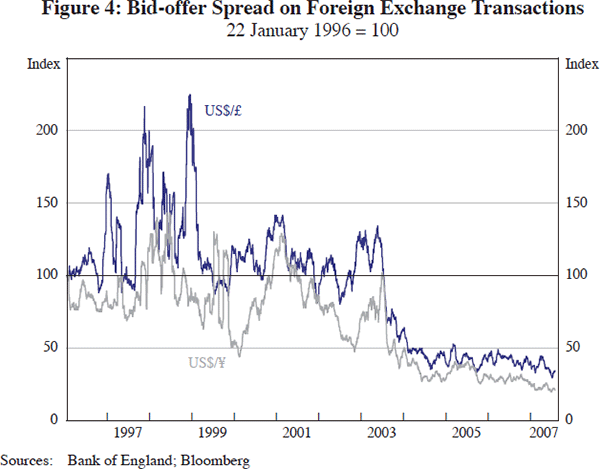
3. Impact on Users of Financial Services
Financial innovation and globalisation have substantially increased the availability of credit to households and corporations and widened the menu of financial products to suit diverse demands. These changes have supported the growth of economic activity (Levine, Loayza and Thorsten 2000). The gains in financial system efficiency have lowered the cost of capital for firms and improved the ability of households to smooth their lifetime consumption and to insure against unexpected outcomes.
The increase in market access and in the breadth of borrowing options has delivered products better-matched to customers' needs. For example, on the corporate side, over the past 20 years, the number of firms with direct access to capital markets has grown substantially (Figure 5). And there has been an increase in the availability of long-term debt (Figure 6), which may be more suited to the characteristics of corporate investment. Borrowing is readily available at both fixed and floating interest rates. Moreover, the ability of non-financial firms to manage their risks has been transformed by their increasing use of derivatives, particularly for managing interest rate and currency risk (Figure 7), but also for other exposures such as those to commodity prices.
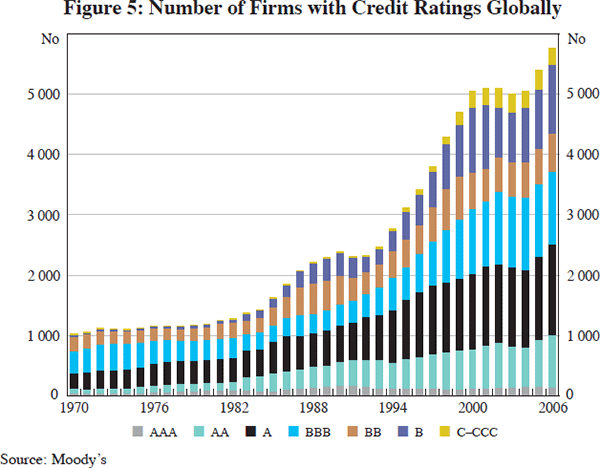
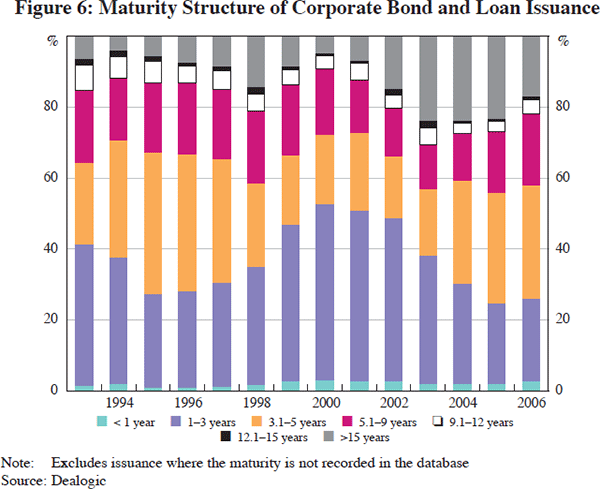
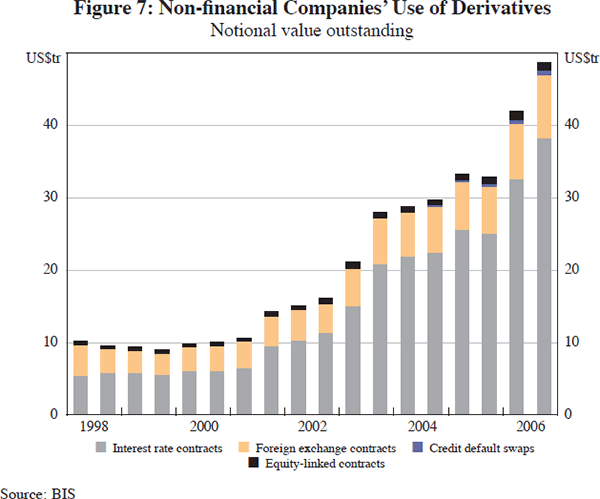
Households have also benefited from a wider range of mortgage and unsecured borrowing products. For example, 25 years ago, mortgage choice in the UK was easy – households could choose either a repayment mortgage, with interest based upon banks' standard variable rates, or an endowment mortgage, with interest again based on the standard variable rate, but with a separate investment fund aimed at repaying the principal. Now mortgage types include: repayment; endowment; pension; negatively-amortising; interest-only; and lifetime mortgages. The rate may be determined by reference to a floating, tracker or fixed rate for maturities between 2 to 25 years. And products may incorporate additional facilities such as cash back, payment of professional fees or lock-in periods. In addition to borrowing for house purchase, individuals have increasingly been able to undertake mortgage equity withdrawal – delivering borrowing for consumption at secured rather than unsecured rates. And the cost of secured funding has fallen – for example, in the UK the average spread on mortgages has fallen from 1.5 percentage points above LIBOR in 1999 to 0.3 percentage points in the first half of 2007. These options have broadened choice. And the process of evolution is continuing. The recent growth of the fledgling house-price derivatives market suggests that ultimately households may be able to hedge housing risk. Of course, the increase in complexity of households' borrowing choices increases their exposure to new risks, placing a premium on financial advice and education.
In addition to an increase in borrowing options, there has also been an increase in credit availability – reflecting a number of interrelated factors. First, the removal of quantity rationing, for example by reducing, and in many cases eliminating, the use of cash ratio requirements as an active mechanism for monetary control (King 1994). Second, the reduced cost of borrowing. And third, the increase in risk-based pricing, which has supported the extension of credit to reach higher-risk customers and thus lowered constraints (Berger, Frame and Miller 2002). Access to capital markets by sub-investment grade firms has increased (Figure 5), and leveraged finance has risen sharply (Figure 8). Households have also had broader access to credit – for example, in the UK, two-thirds of adults had a credit card in 2006, double the proportion in 1984 (Figure 9). During this time, households' total unsecured borrowing increased from 5 per cent to 24 per cent of household income. And across the G7 economies, household debt relative to income has increased by an average of four-fifths in the past 20 years (Figure 10),[2] suggesting a marked easing of credit constraints.
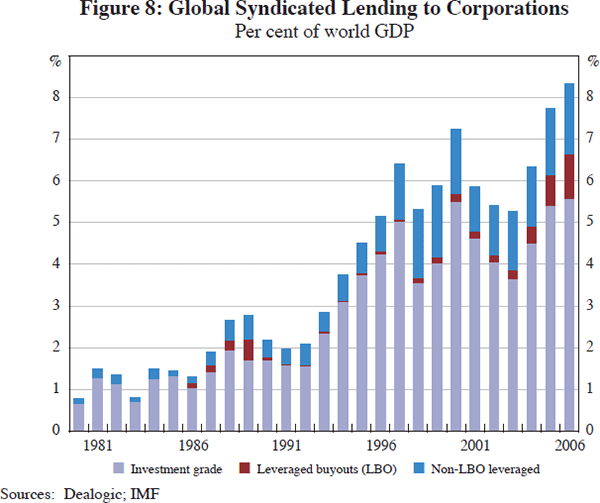
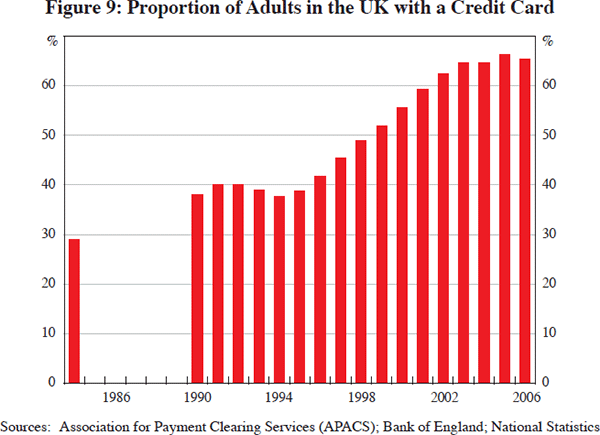
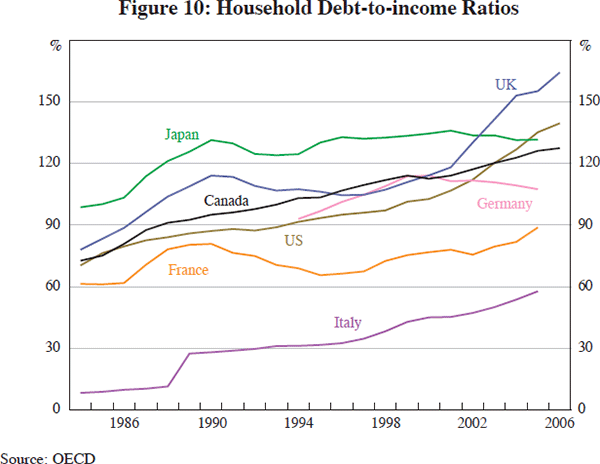
The range of investment vehicles available to households and firms has also changed fundamentally over recent decades. For example, 35 years ago, equities in the US were mainly held directly by domestic households; now, they are mainly held indirectly through institutional investors, with different funds providing a large menu of different risk/return trade-offs (Figure 11). The increasing range of options has enabled even small retail investors to develop more diversified, tailored and complex portfolios – including gaining exposure to property, commodity and foreign exchange risk. Once again, this has placed a premium on financial acumen, especially as previous investment returns may not provide a good guide to likely future returns.
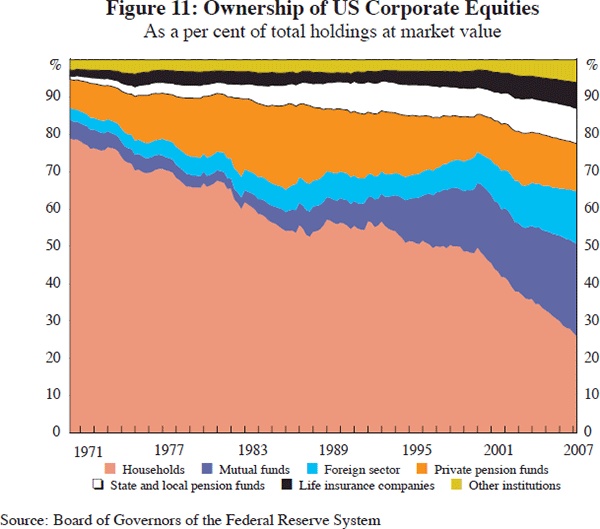
In addition to the greater choices over investment and borrowing opportunities, households in many countries are becoming increasingly responsible for financing costs which were previously socialised and borne by governments (Caruana 2007). These costs include pension provision, tertiary level education, health care and long-term old-age support.
Although the largest investment vehicles remain pension and mutual funds, there has been huge growth in alternative investment funds – aimed primarily at the wealthier investor – which offer the prospect of higher, but potentially riskier, returns. These include hedge funds, where the number of firms has increased by a factor of 8 in the past 15 years (Figure 12), and private equity companies. These newer investment vehicles look to achieve higher returns by more active management and/or by taking on higher risks – perhaps by moving down the credit or liquidity spectrum into volatile or illiquid instruments, or by using leverage. Lower costs of financial market participation have also led to an increase in the number of retail investors and ‘day-traders’, who actively participate in foreign exchange and other markets, with the involvement of Japanese investors in the yen carry trade a prime example.
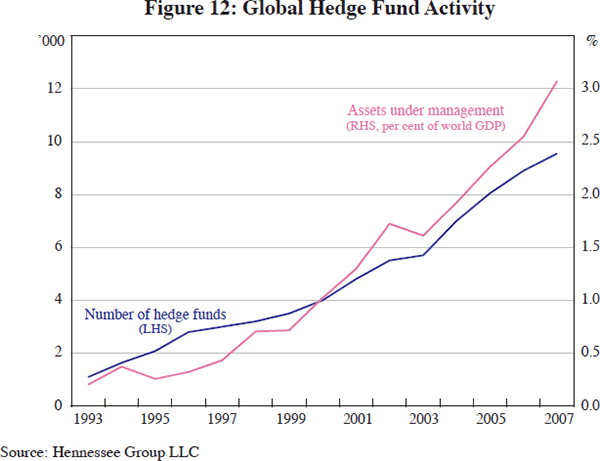
A direct consequence of households and companies taking up a wider variety of financial market instruments is that their individual balance sheets have become more complicated. A household could, for example, be managing a hybrid residential mortgage loan, which allows equity withdrawal to finance other goods and services, a buy-to-let loan for an investment property, a pension, and an investment portfolio of domestic equities and foreign currency bonds. If well managed, a complex balance sheet like this example provides considerable flexibility for households to smooth consumption and to maximise lifetime opportunities. Given sensible use of diversification and a buffer of capital, households can also make themselves more robust to temporary shocks, such as a spell of unemployment. Companies can do exactly the same. Although sustained healthy economic growth and low macroeconomic volatility are almost certainly the strongest influences, the low rate of corporate defaults in recent years may in part reflect increased use of hedging products that strengthen companies' capability to weather temporary shocks. Indeed there may be a possible mutually reinforcing effect. Households and corporations that have increased their financial robustness do not need to make sharp adjustments to their expenditure patterns in the event of an external shock, thereby reducing the potential amplitude of the change in overall spending.
Nevertheless, agents attempting to optimise their balance sheets through additional use of financial instruments have to form an expectation of risks at a particular point in time, and so are not immune from expectational errors or from changes beyond their planning horizon. For example, a company may be able to swap its floating-rate loan for a fixed rate, hedge its foreign currency exposures, buy forward any commodity inputs, buy credit protection against the failure of a supplier and buy volatility protection against major movements in the value of assets in its staff's pension plan. By locking in prices today, the firm protects itself against the vagaries of short-term market volatility. But such hedges rely on accurate forecasts of future risks – and firms could find themselves under- or over-hedged. In addition, immunity from market movements may also make it difficult to pick up latent deterioration in the firm's profitability, which may only become apparent when the hedges mature and the institution is forced to rehedge and refinance. This can make the assessment of credit risk more challenging because a balance sheet can look impervious to shocks in the short run but remain vulnerable to subtle shifts in fundamentals in the longer run.
4. Implications for the Financial System
Innovation, deregulation and integration are significantly changing the way the financial system operates and manages its risks.[3] This offers substantial benefits but also poses different and difficult challenges for financial institutions. This section examines the implications more closely.
The ability of financial firms to hedge and diversify exposures, as well as to transfer risks to other financial institutions or agents who are more willing or able to bear it, has transformed the way financial institutions manage risk in recent years (CGFS 2003). The rapid growth of derivatives and options underpins this transformation. For although derivative markets for physical commodities were first launched in 1898, their extensive use in financial contracts is of course a very modern development. The first financial futures contract was introduced on the Chicago Mercantile exchange only 35 years ago in May 1972. But by 2006, over 5 billion contracts were traded globally, with a dramatic increase over the past decade. Similarly, use of over-the-counter (OTC) derivatives has increased sharply – with the notional value outstanding increasing five-fold since 1998 (Figure 3). A particularly important innovation has been the development of the credit derivatives market. This has grown at a tremendous pace, with the International Swaps and Derivatives Association (ISDA) reporting an increase in the notional value outstanding from US$0.6tr in 2001 to US$34tr in 2006. Credit derivatives offer banks and other institutions the facility to lay off (and to take on) credit risks much more easily than before. And credit derivatives have also spawned the growth of synthetic credit products and broken the link with the physical supply of debt – credit positions on a particular corporation may be many multiples of the physical volume of debt outstanding.[4] The use of options has also increased dramatically, with the BIS reporting that the notional value of contracts has increased almost five-fold since 1998. These contracts have enhanced financial institutions' ability to hedge complex risks and enabled users to take on (and protect themselves against) exposure to specific risks – for example, by providing protection against extreme downside movements in a particular asset price.
The structure of the financial system is also changing. Historically, banks could only originate as many loans as they had the capacity to finance, subject to strict concentration limits. But the ability to securitise and hedge portfolios of loans has enabled two key functions of banks – the origination and holding of credit risk – to be separated. The process started in the early 1970s, with residential mortgage-backed securitisations by government agencies in the US. Activity has grown very rapidly over the past 10 years (Figure 13), as banks have securitised retail mortgages and a wide range of other assets, most prominently commercial mortgages and consumer credit. There have been equally profound changes in credit risk management in recent years, underpinned by growth in credit derivatives. That has fuelled a surge in complex structured finance products, such as collateralised debt obligations (CDOs), which have tripled since 2004. CDOs can be backed by a relatively diverse array of bonds, loans or other assets, and by enabling the pooling and slicing of risk to meet investor demand they increase the scope of loans which can be on-sold.
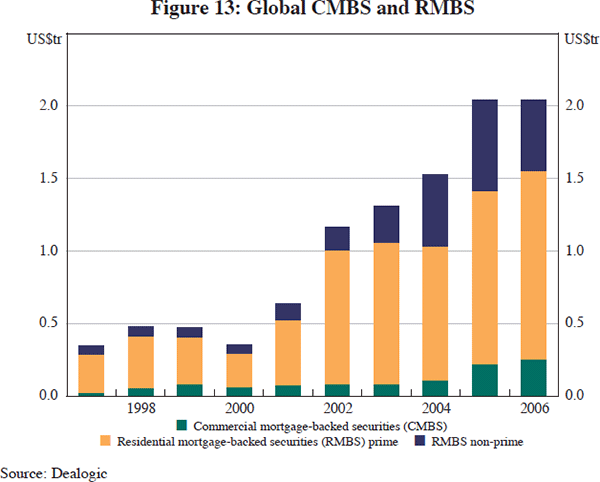
Banks are taking advantage of the ability to separate the screening and monitoring of loans from the provision of term financing and moving more towards an ‘originate and distribute’ or ‘arms-length financing’ business model, whereby loans are originated and then repackaged and sold on as a security. This enables banks to maximise the value they can achieve from knowledge of borrowers' and lenders' needs through developing relationships, but at the same time economise on capital. Perceived differences between the regulatory and economic cost of capital may have increased the incentive to securitise and thus accelerated this process. The transition towards greater arms-length financing is more pronounced in the United States and the United Kingdom than in many other countries (IMF 2006), but the underlying drivers are common across countries.
Arms-length financing can bring some advantages for the system as a whole. Credit risk can be dispersed amongst a wider range of investors, helping to reduce the concentration of exposure. Moreover, risk can be transferred to those with high tolerance or capacity to absorb it. In theory, credit risk could be moved away from the core settlement banks, thereby protecting the payments system from major credit shocks. But in practice, banks' balance sheets have still continued to expand rapidly in recent years – with the largest 10 UK banks tripling their total assets in the past 10 years, in part through acquisition as well as organic growth (Figure 14). Furthermore, the 16 LCFIs identified in the (April 2007) Bank of England Financial Stability Report (FSR) have more than doubled their balance sheet since 2000, supported by a large increase in holdings of trading assets – in part due to greater proprietary risk-taking, but also reflecting increased warehousing of assets supporting ‘originate and distribute’ activity (Figure 15).
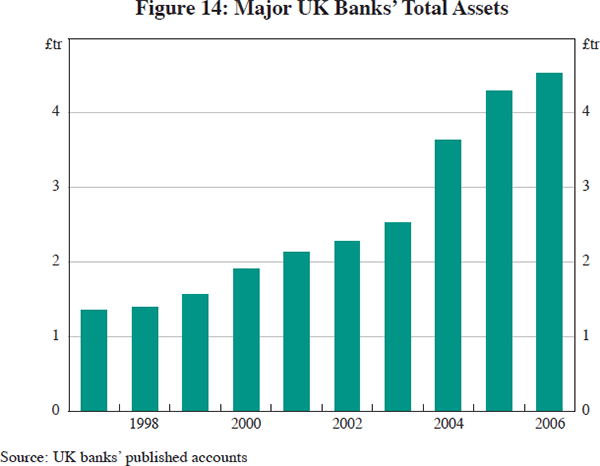
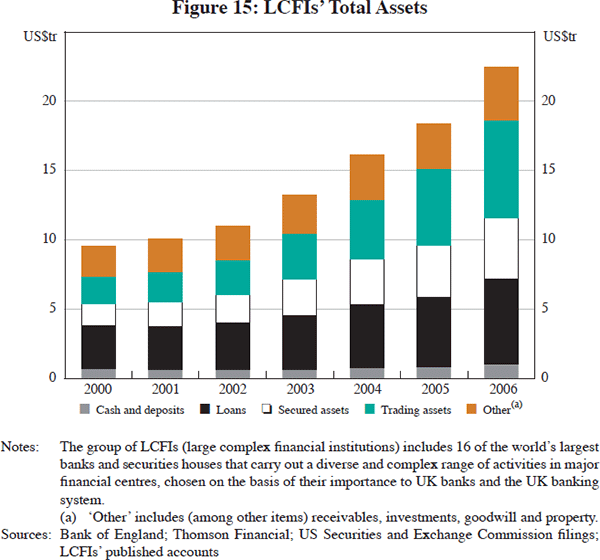
Dispersed credit risk though does have potential costs. A lender with a concentrated exposure to a creditor has a powerful incentive to screen and monitor credit risk. The incentive weakens as risk becomes more and more dispersed. So greater arms-length financing may well weaken credit assessment across the system as a whole.[5] And increased reliance is likely to be placed on specialists such as rating agencies.
Increased use of securitisation as a funding source and risk management tool is also changing the nature of liquidity risks in the banking sector (IIF 2007). Historically, banks have been vulnerable to liquidity runs because they have had liquid deposit liabilities but illiquid loan assets. Securitisation affects this vulnerability in a number of ways. First, the mismatch in maturity between assets and liabilities is lessened if long-dated assets are typically sold. Second, banks can now sell down loans they retain on their balance sheet if they come under pressure in normal market conditions, as securitisation has created a market for what were previously illiquid assets (though care, of course, is needed to avoid any impression of weakness or a ‘fire sale’). Third, banks can originate a large volume of loans from a given base of customer deposits and capital by turning over their balance sheet more quickly. Typically, originated assets awaiting securitisation are built up in ‘warehouses’ financed by wholesale deposits. These deposits are generally less sticky than traditional customer funding. So while assets are more liquid, liabilities may be too, placing additional emphasis on active liquidity management and contingency funding arrangements.
There has to be some difference of opinion to make a market, but not too much. Indeed Governor Warsh of the US Federal Reserve recently described market liquidity as synonymous with confidence (Warsh 2007b). However, market liquidity is potentially fragile if there are changes in fundamentals that increase uncertainty, because liquidity does not depend solely on a trader's expectations about the change in risk but also reflects his or her beliefs about the expectations of other traders (and so on). A trader will be cautious about committing to buy a financial asset at a price they regard as fair, if they judge that other traders will consider it too high and so expect the price to fall further. This strategic behaviour may amplify shocks and lead to traders requiring a higher risk premium. Indeed it may lead them to take themselves out of the market entirely in response to adverse news. As a result, liquidity can quickly evaporate from markets in response to a fundamental shock (especially to expectations) and these dynamic reactions can contribute to the fatness of tails in the distribution of returns. If there is a corresponding flight to quality, there can also be sharp movements in the correlation between financial products. Market liquidity risk is therefore inherently difficult to price and manage.
The increase in institutions' and investors' cross-border activity is also leading to greater synchronisation and correlated movements across international markets. Through greater spreading and shifting of risks to holders overseas, domestic markets may thus be less vulnerable to country-specific shocks. But by the same token, increased globalisation of markets has raised the scope for spillover and contagion between markets, reducing the benefits of diversification as market synchronisation has increased. For example, the first principal component of equity returns across the US, UK, Japanese and euro area exchanges has increased from about a third in 1980 to around two-thirds (Figure 16), while a similar measure of the co-movement in changes in nominal bond yields has also increased strongly (Figure 17). Moreover, co-movement tends to rise sharply during times of severe stress, such as at the time of the 1987 stock market crash, as investors collectively seek to reduce exposure to higher-risk assets across the board, leading to pressure on market liquidity.
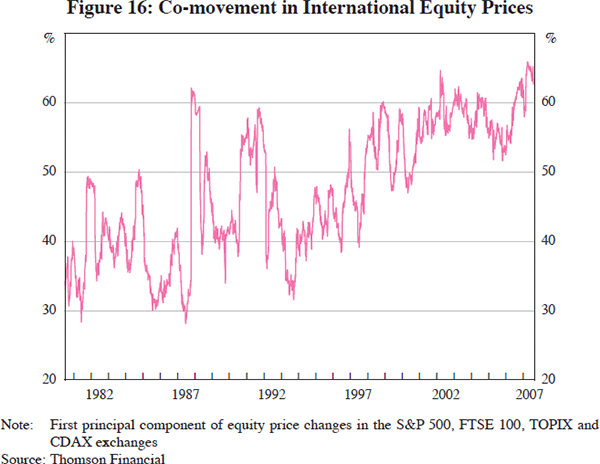
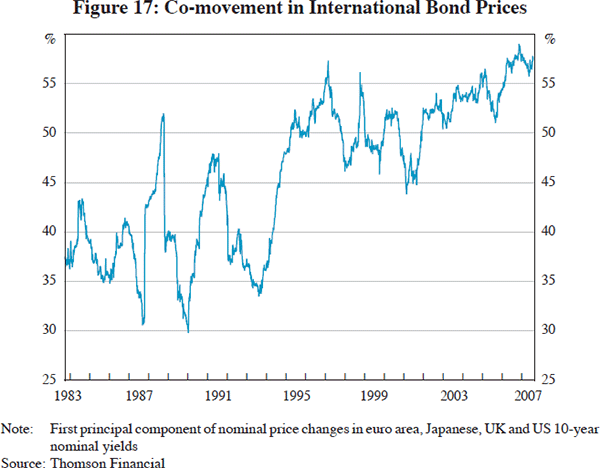
5. Looking Forward – Issues and Risks
So how have these changes affected the performance of the financial sector in recent years, and what issues and risks do they raise looking forward? Financial institutions have been highly profitable in recent years. Economic conditions have been generally benign – strong global growth and low macroeconomic volatility have supported corporate profits and household disposable income. Moody's report that global corporate default rates remain around their lowest levels since their series began 25 years ago. So corporate credit losses have been very low by historical standards. Credit premia have narrowed substantially in recent years, notwithstanding the marked increase of spreads very recently as conditions have tightened (Figure 18). Banks and other investors (such as institutional funds and hedge funds) have consequently made large mark-to-market profits on asset holdings in recent years. Very high financial market activity has also supported trading income and fee income.
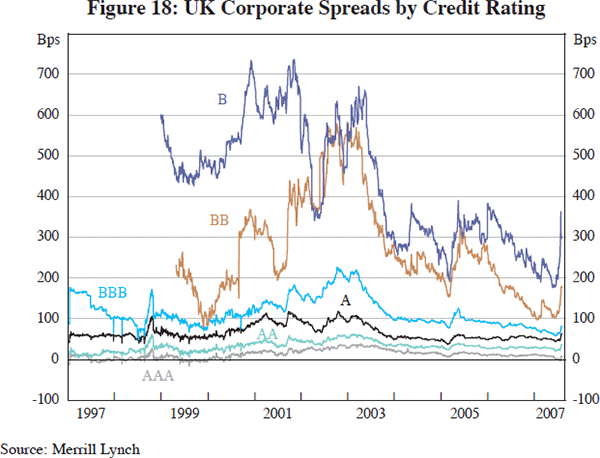
Some of the gains made by the financial sector in recent years are consequently likely to be one-off, reflecting the adjustments in asset prices to an environment of lower macroeconomic volatility and sustained low inflation, supported by the remarkable pace of financial innovation and financial deepening, and, until very recently, the buoyancy of market liquidity, itself linked partly to accommodative monetary conditions which have now been largely unwound. Strong global liquidity conditions in recent years have reduced the return to the standard liquidity transformation function of the banking system. Low liquidity premia have encouraged banks to shift down the liquidity spectrum and/or increase the amount of market and credit risk they are prepared to take. And this search for yield has encouraged firms to write protection against a wider range of financial market outcomes.
While a number of structural forces supporting greater financial deepening are likely to continue, such as the pressure to exploit economies of scale described above, and the extensive opportunities in emerging economies, the future environment for the financial sector is unlikely to be as benign as in recent years (Bank of England 2007).
The current situation in financial markets is illustrating some of the key risk management challenges, in particular the importance of collective behaviour and the scope for sharp price adjustments if confidence and market liquidity are jolted.
In advance of the current market turbulence, the compensation for taking future risk had fallen sharply given the marked narrowing of credit risk and liquidity premia in recent years. That, of course, presented no issues if the reduction in compensation had matched the reduction in perceived risks. But, in practice, as highlighted in Bank of England FSRs and elsewhere, there were reasons to suspect that this was not the case, as investors were seeking additional yield and market frictions were limiting full arbitrage.
Before the recent correction in credit markets, a persistent theme from many market contacts was that the compensation for credit risk was too low in their view. Yet at the same time, the contacts judged that it was in their optimal long-run business interest to retain an active presence in the market, at the cost of running additional financial risk. That would enable them to maintain placings in league tables and thus avoid losing market share against their peers. Short-term performance targets for compensation purposes may have added to the incentives to remain with the herd and raised the costs of taking a contrarian position to provide effective market arbitrage. As noted in recent Bank of England FSRs, this collective behaviour increased systemic financial risk. The potential for a sudden, and potentially sharp, reversal in low risk premia was raised. Individual firms appeared to be overly confident of their ability to exit positions at limited cost, failing to take full account of the collective impact of a change in sentiment on market prices given the potential evaporation of market liquidity as other risk holders rushed to hedge or exit positions. That is one reason why the Bank's judgment in the April FSR was that the vulnerability of the system as a whole to an abrupt change in conditions had increased, notwithstanding the judgment that the system remained highly resilient.
Although events are still unfolding, the recent sharp correction in financial markets in response to a reappraisal of credit risks and the valuation of complex credit products, in the wake of the losses in the US sub-prime markets, demonstrates the importance of market liquidity and the scope for market adjustments to be amplified by collective behaviour in response to shocks.[6] It also demonstrates the importance of strong credit assessment as fundamental values are reasserted in the longer run, and, finally, the greater dispersion of risk internationally as losses are spread across a wide range of financial firms and investors.
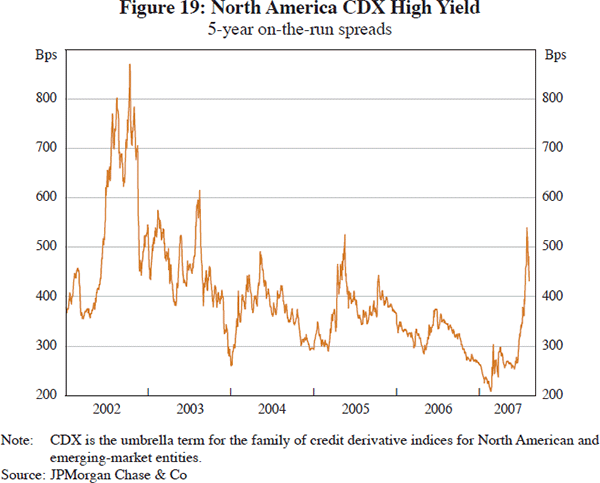
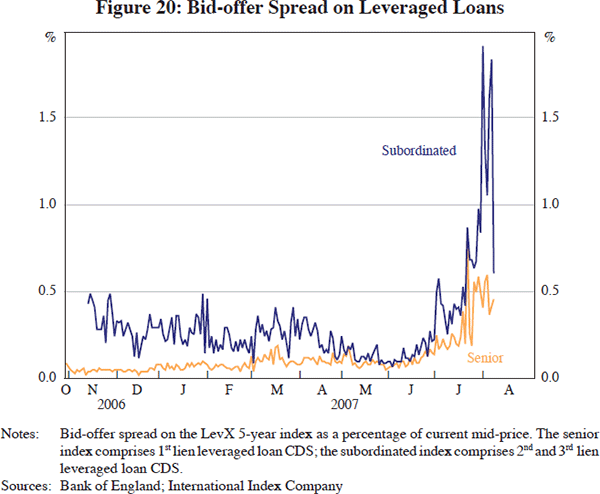
Looking forward, sustaining the pace and rents from financial innovation might prove challenging, as margins on new products are quickly bid away and there are likely to be diminishing returns to increased complexity. Indeed, before the recent market turbulence, contacts were reporting that the arrangement fee and margin on a vanilla RMBS/CMBS had been depressed to such a point that the business was often seen by banks as a loss-leader, and was only undertaken in order to gain fees and commissions from related business. Moreover, question marks over the reliability of valuations of complex products such as CDOs given very thin and illiquid secondary markets have, at least temporarily, dulled the appetite for the more complex and risky instruments. Nonetheless, pressure to innovate is likely to intensify once again in the medium term, given strong global competition in financial markets.
As competition in global financial markets continues to increase, risk-adjusted returns are likely to fall, absent a further stream of major innovations that warrant exceptional returns for a time. It is worth recalling a basic economic principle that super-normal profits are not necessarily a good measure of financial stability. Indeed, from a baseline of fully competitive markets, high profit growth would be an indicator of increased risk-taking. As Bank of England Governor, Mervyn King, put it in his recent Mansion House speech: ‘Higher returns come at the expense of higher risk’ (King 2007). That is an old adage worth holding onto.
So how are these market developments affecting the risks to systemic financial stability? On the one hand, financial innovation and greater cross-border integration have facilitated the management and dispersal of risks, improving risk allocation and lowering sectoral and regional risk concentrations. Moreover, the growth of new investors, such as hedge funds, prepared to take contrarian positions, has added to market liquidity under normal conditions. These factors are likely to have strengthened the resilience of the financial system to withstand small-to-medium shocks, as such shocks are more readily dissipated. But, equally, innovation and integration have extended the ties between financial firms within and particularly across borders. In the event of a very large adverse shock these ties could consequently act as a conduit to transmit problems rather than to absorb them. And in such conditions, a lowering of the appetite for risk and pressure for withdrawals from investors could lead to asset managers increasing their liquidity buffers and thus adding to the drain on market liquidity.
6. Challenges for Financial Stability Authorities
As highlighted in the earlier sections, innovation and the major structural changes in financial markets in recent years have delivered considerable benefits to consumers and users of financial services. A wider choice of financial products with much greater flexibility of terms and conditions is on offer for both savers and borrowers. And competition has enhanced efficiency and lowered costs. As recently discussed by Governor Warsh, these developments have added to the depth and completeness of markets and to value-added and economic welfare (Warsh 2007a).
Yet, as also highlighted above, the financial system is a highly interdependent network and prone to microeconomic distortions arising from asymmetric information. Failure of a major institution may readily spill over to other parts of the financial system through direct credit linkages, through indirect channels such as the impact of failure on the value of common asset holdings or exposures, and through more nebulous channels such as the impact on confidence. More broadly, the consequences of the failure of a major institution on the financial system as a whole are likely to be much larger than on the institution itself, providing the standard justification for regulatory intervention to align the incentives facing financial institutions with public policy goals.
So how have the forces of innovation and integration affected the challenges for public authorities in preserving financial stability?[7] We would briefly highlight the importance of four areas of work in particular:
- First, improving the understanding of systemic risk and developing a robust toolkit to assess and analyse risks to financial stability remains a formidable challenge. Although stress-testing offers a promising avenue, the current state of the art is some way short of ideal. In particular, current approaches typically place relatively limited attention to default, to contagion risks and to system responses and interconnections. But of course these elements lie at the heart of episodes of major instability and financial crisis. At the Bank of England we plan to address this deficiency by developing a suite of models that focus more particularly on network links and financial system responses to shocks (for example, on liquidity and credit supply) (Jenkinson 2007a). This suite should aid our analysis and judgments. But it will also be essential to complement this analytical work with high-quality market intelligence to ensure that our assessment is grounded in a good understanding of rapidly evolving, complex financial markets (Haldane, Hall and Pezzini 2007). That is inevitably challenging given the pace of innovation and structural change.
- Second, delivering effective capital and liquidity buffers. An improved assessment of the threats to financial stability should assist the authorities in identifying areas of vulnerability and weakness in the system to address in conjunction with financial firms. One important strand of work is setting standards for capital and liquidity buffers to provide protection to the system as a whole. In recent years, attention has been focused on the development, and now implementation, of the Basel II capital standards. The new standards have improved the risk sensitivity of capital levels to the spectrum of risks faced by banks. Moreover, as emphasised earlier, market and funding liquidity risks are increasing in importance given the growth of capital markets, of securitisation, and of the originate and distribute model of banking. That in turn raises the importance of liquidity standards and supervision.
- Third, promoting resilient financial market infrastructure. As financial institutions and private agents rely increasingly on financial markets to trade, manage and hedge risks, the importance of reliable, robust infrastructure for trading, payments, clearing and settlement is paramount. However, there are a number of market failures such as network externalities and the tendency for natural monopoly, as well as collective action problems, which imply that the private sector alone may underinvest in infrastructure resilience, and provide a role for public sector intervention to ensure that broader social welfare objectives are captured (Jenkinson 2007b).
- Fourth, improving international financial crisis management planning. The sharp growth in global financial business and in cross-border financial consolidation, together with the increased pace of capital market activity, has increased the complexity and difficulty of managing and resolving any emerging financial crises. As noted above, though market developments may have lowered the likelihood of crises, they have, at the same time, increased the probability of a crisis spilling across borders should one occur. That places a premium on strengthening dialogue and preparations among authorities which may share common problems (Gieve 2006), for example, through the formation of interest groups.[8]
7. Conclusion
Deregulation and technological change have unleashed tremendous competitive forces on the global financial system in recent years, resulting in enormous growth and innovation in the provision of financial services. That has provided substantial benefits to the wider economy by providing households and corporations a much wider menu of instruments with which to borrow, lend and manage risk, though at the same time the broadening of choice and exposure to new risks has increased the premium on high-quality financial advice and knowledge. The breakdown of barriers to the supply of financial products and the large volume of risk pooling and shifting within and across borders have increased the interconnections and integration within the financial system as well as adding to the complexity of the system. Understanding and addressing the risks in an increasingly integrated and increasingly global financial system is a major challenge for financial institutions and financial stability authorities. Meeting these challenges is crucial to ensure that risks are contained and that the manifold benefits of innovation and integration in financial markets can be sustained.
Footnotes
We are grateful to John Gieve and Laurie Roberts for helpful comments and Jake Horwood and Rachel Pigram for research assistance. [1]
The trend has been even more pronounced in Australia, with the ratio of debt-to-income more than doubling in the past 10 years. [2]
See also Rajan (2005). [3]
For example, in the case of the bankruptcy filing of the US automobile components firm Delphi in 2005, the value of credit derivatives related to this company was more than 10 times the par value of its bonds outstanding. [4]
Reputational risk ensures that banks continue to have some incentives to assess credit risks properly. In addition, the market may expect them to retain some residual exposure to the loans they securitise – although banks could hedge some of this exposure through the credit derivatives market. [5]
As highlighted by the sudden spike in the price of credit insurance on high-yield corporate debt (Figure 19) and by the sharp rise in the bid-offer spread on an index of leveraged loans (Figure 20). See also Bank of England (2006). [6]
See Bernanke (2007). [7]
An example of this is the Trans-Tasman Council on Banking Supervision, which brings together the relevant authorities in Australia and New Zealand. [8]
References
Bank of England (2006), ‘Box 5 Financial Market Amplifiers’, Financial Stability Report, Issue No 20, p 33.
Bank of England (2007), ‘The Monetary Policy Committee of the Bank of England: Ten Years On’, Bank of England Quarterly Bulletin, 47(1), pp 24–38.
Berger AN, WS Frame and NH Miller (2002), ‘Credit Scoring and the Availability, Price, and Risk of Small Business Credit’, Board of Governors of the Federal Reserve System Finance and Economics Discussion Series No 2002–26.
Bernanke BS (2007), ‘Regulation and Financial Innovation’, speech to the Federal Reserve Bank of Atlanta's 2007 Financial Markets Conference on ‘Credit Derivatives: Where's the Risk?’, Sea Island, 15 May.
Caruana J (2007), ‘Global Financial Market Risk – Who Is Responsible for What?’, keynote address at the Heinrich Böll Foundation/German Association of Banks Conference on Financial Stability, Berlin, 30 May.
CGFS (Committee on the Global Financial System) (2003), ‘Credit Risk Transfer’, CGFS Publications No 20.
Ferguson R, P Hartmann, and R Portes (forthcoming), International Financial Stability, Geneva Reports on the World Economy, International Center for Monetary and Banking Studies and CEPR, Geneva.
Gieve J (2006), ‘Practical Issues in Preparing for Cross-Border Financial Crises’, speech at the Financial Stability Forum Workshop on ‘Planning and Communication for Financial Crises and Business Continuity Incidents’, Bank of England, London, 13 November.
G10 (Group of 10) (2001), Report on Consolidation in the Financial Sector, G10, Basel. Available at <http://www.imf.org/external/np/g10/2001/01/Eng/index.htm>.
Haldane A, S Hall and S Pezzini (2007), ‘A New Approach to Assessing Risks to Financial Stability’, Bank of England Financial Stability Paper No 2.
Heikkinen P and K Korhonen (2006), Technology-Driven Efficiencies in Financial Markets, Bank of Finland Expository Studies No A:110.2006, Bank of Finland, Helsinki.
IIF (Institute of International Finance) (2007), ‘Principles of Liquidity Risk Management’, report of the IIF Special Committee on Liquidity Risk, March.
IMF (International Monetary Fund) (2006), World Economic Outlook – Financial Systems and Economic Cycles, World Economic and Financial Surveys, IMF, Washington DC.
Jenkinson N (2007a), ‘Developing a Framework for Stress Testing of Financial Stability Risks’, speech at the ECB Conference on ‘Stress Testing and Financial Crisis Management’, Frankfurt, 12 July.
Jenkinson N (2007b), ‘Promoting Financial System Resilience in Modern Global Capital Markets: Some Issues’, speech at the 2nd International Conference on ‘Law and Economics of Risk in Finance’, University of St Gallen, St Gallen, 29 June.
King M (1994), ‘Monetary Policy Instruments: The UK Experience’, Bank of England Quarterly Bulletin, August, pp 268–276.
King M (2007), speech given at the Lord Mayor's Banquet for Bankers and Merchants of the City of London at the Mansion House, 20 June. Available at <http://www.bankofengland.co.uk/publications/speeches/2007/speech313.pdf>.
Levine R, N Loayza and B Thorsten (2000), ‘Financial Intermediation and Growth: Causality and Causes’, Journal of Monetary Economics, 46(1), pp 31–77.
Rajan RG (2005), ‘Has Financial Development Made the World Riskier?’, NBER Working Paper No 11728.
Warsh K (2007a), ‘Financial Intermediation and Complete Markets’, speech at the European Economics and Financial Centre, London, 5 June. Available at <http://www.federalreserve.gov/boarddocs/speeches/2007/200706052>.
Warsh K (2007b), ‘Market Liquidity: Definitions and Implications’, speech at the Institute of International Bankers Annual Washington Conference, Washington DC, 5 March. Available at <http://www.federalreserve.gov/boarddocs/speeches/2007/20070305>.